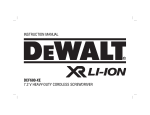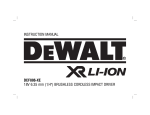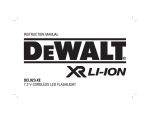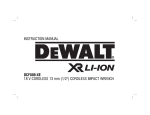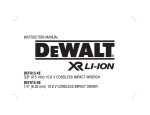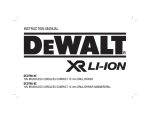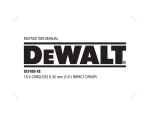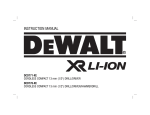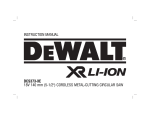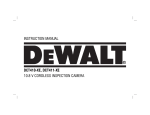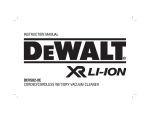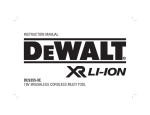Download DeWalt DW9108 Instruction manual
Transcript
INSTRUCTION MANUAL DCR016-XE JOB SITE RADIO CAUTION: Burn hazard. To reduce the risk of injury, charge only DEWALT rechargeable batteries. Other types of batteries may burst causing personal injury and damage. CAUTION: Danger of explosion if internal battery is incorrectly replaced. Replace only with the same or equivalent type. • Do not abuse cord. Never carry the radio by its cord. Never pull the cord to disconnect from the socket. Keep the cord away from heat, oil and sharp edges. • Remove the battery pack. Switch off before leaving it unattended. Remove the battery pack when not in use before servicing. • This appliance is intended to be used in moderate climates. • This appliance is not intended for use by persons (including children) with reduced physical, sensory or mental capabilities, or lack of experience and knowledge, unless they have been given supervision or instruction concerning use of the appliance by a person responsible for their safety. • Children should be supervised to ensure that they do not play with the appliance. • Radio shall not be exposed to dripping or splashing; no objects filled with liquids, such as vases, shall be placed on it. • No exposed flame sources, such as lighted candles, should be placed on the radio/charger. • Mains plug is used as the disconnect device; the disconnect device (plug) shall remain readily operable. • Young children and the infirm. This appliance is not intended for use by young children or infirm persons without supervision. – This appliance is not intended for use by persons (including children) with reduced physical, sensory or mental capabilities, or lack of experience and knowledge, unless they have been given supervision or instruction concerning use of the appliance by a person responsible for their safety. – Children should be supervised to ensure that they do not play with the appliance. • Replacement of the supply cord. If the supply cord or plug is damaged, it must be replaced by the manufacturer or an authorised DEWALT Service Centre in order to avoid a hazard. Definitions: Safety Guidelines The definitions below describe the level of severity for each signal word. Please read the manual and pay attention to these symbols. DANGER: Indicates an imminently hazardous situation which, if not avoided, will result in death or serious injury. WARNING: Indicates a potentially hazardous situation which, if not avoided, could result in death or serious injury. CAUTION: Indicates a potentially hazardous situation which, if not avoided, may result in minor or moderate injury. NOTICE: Indicates a practice not related to personal injury which, if not avoided, may result in property damage. IF YOU HAVE ANY QUESTIONS OR COMMENTS ABOUT THIS OR ANY DEWALT TOOL, CALL US AT: 1800 338 002 (Aust) or 0800 339 258 (NZ). Technical Data Power source Mains voltage Battery voltage Battery type Weight VAC VDC kg DCR016 AC/DC 230–240 10.8–18 Li-Ion 5.7 Safety Instructions for Charger/Radios SAVE THESE INSTRUCTIONS: This manual contains important safety and operating instructions for the DCR016 charger/radio. WARNING: Shock hazard. Do not allow any liquid to get inside radio. Electric shock may result. WARNING: Batteries (battery pack) shall not be exposed to excessive heat such as sunshine, fire or the like. 1 SAVE THESE INSTRUCTIONS • Never force the battery pack into the charger. Do not modify the battery pack in any way to fit into a non-compatible charger as battery pack may rupture causing serious personal injury. Consult the chart at the end of this manual for compatibility of batteries and chargers. • Charge the battery packs only in designated DEWALT chargers. • DO NOT splash or immerse in water or other liquids. • Do not store or use the radio and battery pack in locations where the temperature may reach or exceed 40 °C (105 °F) (such as outside sheds or metal buildings in summer). For best life store battery packs in a cool, dry location. WARNING: Fire hazard. Never attempt to open the battery pack for any reason. If the battery pack case is cracked or damaged, do not insert into the charger. Do not crush, drop or damage the battery pack. Do not use a battery pack or charger that has received a sharp blow, been dropped, run over or damaged in any way (e.g., pierced with a nail, hit with a hammer, stepped on). Damaged battery packs should be returned to the service center for recycling. WARNING: Fire hazard. Do not store or carry the battery pack so that metal objects can contact exposed battery terminals. For example, do not place the battery pack in aprons, pockets, tool boxes, product kit boxes, drawers, etc., with loose nails, screws, keys, etc. Transporting batteries can possibly cause fires if the battery terminals inadvertently come in contact with conductive materials such as keys, coins, hand tools and the like. When transporting individual battery packs, make sure that the battery terminals are protected and well insulated from materials that could contact them and cause a short circuit. SPECIFIC SAFETY INSTRUCTIONS FOR LITHIUM ION (Li-Ion) • Do not incinerate the battery pack even if it is severely damaged or is completely worn out. The battery pack can explode in a fire. Toxic fumes and materials are created when lithium ion battery packs are burned. • If battery contents come into contact with the skin, immediately wash area with mild soap and water. If battery liquid gets into the eye, rinse water over the open eye for 15 minutes or until irritation ceases. If medical attention is needed, the battery electrolyte is composed of a mixture of liquid organic carbonates and lithium salts. • Contents of opened battery cells may cause respiratory irritation. Provide fresh air. If symptoms persist, seek medical attention. Extension Cords CAUTION: Use only extension cords that are approved by the country’s Electrical Authority. Before using extension cords, inspect them for loose or exposed wires, damaged insulation and defective fittings. Replace the cord if necessary. WARNING: We recommend the use of a residual current device with a residual current rating of 30mA or less. • The label on your appliance may include the following symbols. The symbols and their definitions are as follows: V ................. volts A ...............amperes Hz ............... hertz W ..............watts ...........alternating current min ............. minutes ........ direct current ...........alternating or direct current .............. Class I Construction .............earthing terminal ................... (grounded) ..............safety alert symbol .............. Class II Construction …/min .......per minute ................... (double insulated) SAVE ALL WARNINGS AND INSTRUCTIONS FOR FUTURE REFERENCE Important Safety Instructions for All Battery Packs When ordering replacement battery packs, be sure to include the catalog number and voltage. Consult the chart at the end of this manual for compatibility of chargers and battery packs. The battery pack is not fully charged out of the carton. Before using the battery pack and charger, read the safety instructions below and then follow charging procedures outlined. READ ALL INSTRUCTIONS • Do not charge or use the battery pack in explosive atmospheres, such as in the presence of flammable liquids, gases or dust. Inserting or removing the battery pack from the charger may ignite the dust or fumes. 2 • When operating a charger outdoors, always provide a dry location and use an extension cord suitable for outdoor use. Use of a cord suitable for outdoor use reduces the risk of electric shock. • Do not place any object on top of the charger or place the charger on a soft surface that might block the ventilation slots and result in excessive internal heat. Place the charger in a position away from any heat source. The charger is ventilated through slots in the top and the bottom of the housing. • Do not operate the charger with a damaged cord or plug. • Do not operate the charger if it has received a sharp blow, been dropped or otherwise damaged in any way. Take it to an authorized service center. • Do not disassemble the charger; take it to an authorized service center when service or repair is required. Incorrect reassembly may result in a risk of electric shock, electrocution or fire. • Disconnect the charger from the outlet before attempting any cleaning. This will reduce the risk of electric shock. Removing the battery pack will not reduce this risk. • NEVER attempt to connect 2 chargers together. • The charger is designed to operate on standard 230 V household electrical power. Do not attempt to use it on any other voltage. This does not apply to the vehicular charger. WARNING: Burn hazard. Battery liquid may be flammable if exposed to spark or flame. Important Safety Instructions for All Battery Chargers SAVE THESE INSTRUCTIONS: This manual contains important safety and operating instructions for battery chargers. • Before using the charger, read all instructions and cautionary markings on the charger, battery pack and product using the battery pack. WARNING: Shock hazard. Do not allow any liquid to get inside the charger. Electric shock may result. CAUTION: Burn hazard. To reduce the risk of injury, charge only DEWALT rechargeable battery packs. Other types of batteries may overheat and burst resulting in personal injury and property damage. NOTICE: Under certain conditions, with the charger plugged into the power supply, the charger can be shorted by foreign material. Foreign materials of a conductive nature, such as, but not limited to, grinding dust, metal chips, steel wool, aluminum foil or any buildup of metallic particles should be kept away from the charger cavities. Always unplug the charger from the power supply when there is no battery pack in the cavity. Unplug the charger before attempting to clean. • DO NOT attempt to charge the battery pack with any chargers other than the ones in this manual. The charger and battery pack are specifically designed to work together. • These chargers are not intended for any uses other than charging DEWALT rechargeable batteries. Any other uses may result in risk of fire, electric shock or electrocution. • Do not expose the charger to rain or snow. • Pull by the plug rather than the cord when disconnecting the charger. This will reduce the risk of damage to the electric plug and cord. • Make sure that the cord is located so that it will not be stepped on, tripped over or otherwise subjected to damage or stress. • Do not use an extension cord unless it is absolutely necessary. Use of improper extension cord could result in risk of fire, electric shock or electrocution. Chargers Your radio's battery uses a DEWALT charger. Be sure to read all safety instructions before using your charger. Consult the chart at the end of this manual for compatibility of chargers and battery packs. Charging Procedure (Fig. 1) 1. Plug the charger into an appropriate outlet before inserting the battery pack. 2. Insert the battery pack (N) into the charger, as shown in Figure 1, making sure the pack is fully seated in charger. The red (charging) light will blink continuously, indicating that the charging process has started. 3 FIG. 1 N 3. The completion of charge will be indicated by the red light remaining ON continuously. The pack is fully charged and may be used at this time or left in the charger. WEAK BATTERY PACKS: Weak batteries will continue to function but should not be expected to perform as much work. FAULTY BATTERY PACKS: This charger will not charge a faulty battery pack. The charger will indicate faulty battery pack by refusing to light or by displaying problem pack or charger. NOTE: This could also mean a problem with a charger. Indicator Light Operation PACK CHARGING PROBLEM POWERLINE Some chargers have a problem powerline indicator. When the charger is used with some portable power sources such as generators or sources that convert DC to AC, the charger may temporarily suspend operation, flashing the red light with two fast blinks followed by a pause. This indicates the power source is out of limits. PACK CHARGED HOT/COLD DELAY x Important Charging Notes PROBLEM PACK OR CHARGER 1. Longest life and best performance can be obtained if the battery pack is charged when the air temperature is between 18 ° – 24 °C (65 °F and 75 °F). DO NOT charge the battery pack in an air temperature below +4 °C (+40 °F), or above +40 °C (+105 °F). This is important and will prevent serious damage to the battery pack. 2. The charger and battery pack may become warm to the touch while charging. This is a normal condition, and does not indicate a problem. To facilitate the cooling of the battery pack after use, avoid placing the charger or battery pack in a warm environment such as in a metal shed or an uninsulated trailer. 3. A cold battery pack will charge at about half the rate of a warm battery pack. The battery pack will charge at that slower rate throughout the entire charging cycle and will not return to maximum charge rate even if the battery pack warms. 4. If the battery pack does not charge properly: a. Check operation of receptacle by plugging in a lamp or other appliance; b. Check to see if receptacle is connected to a light switch which turns power off when you turn out the lights; c. Move the charger and battery pack to a location where the surrounding air temperature is approximately 18 ° – 24 °C (65 °F and 75 °F); PROBLEM POWERLINE Charge Indicators This charger is designed to detect certain problems that can arise. Problems are indicated by the red light flashing at a fast rate. If this occurs, re-insert the battery pack into the charger. If the problem persists, try a different battery pack to determine if the charger is working properly. If the new pack charges correctly, then the original pack is defective and should be returned to a service center or other collection site for recycling. If the new battery pack elicits the same trouble indication as the original, have the charger and the battery pack tested at an authorized service center. HOT/COLD DELAY This charger has a hot/cold delay feature: when the charger detects a battery that is hot, it automatically starts a delay, suspending charging until the battery has cooled. After the battery has cooled, the charger automatically switches to the pack charging mode. This feature ensures maximum battery life. The red light flashes long, then short while in the hot/cold delay mode. LEAVING THE BATTERY PACK IN THE CHARGER The charger and battery pack can be left connected with the charge indicator showing Pack Charged. 4 COMPONENTS (FIG. 2–4) d. If charging problems persist, take the radio, battery pack and charger to your local service center. 5. The battery pack should be recharged when it fails to produce sufficient power on jobs which were easily done previously. DO NOT CONTINUE to use under these conditions. Follow the charging procedure. You may also charge a partially used pack whenever you desire with no adverse effect on the battery pack. 6. Foreign materials of a conductive nature such as, but not limited to, grinding dust, metal chips, steel wool, aluminum foil, or any buildup of metallic particles should be kept away from charger cavities. Always unplug the charger from the power supply when there is no battery pack in the cavity. Unplug the charger before attempting to clean. 7. Do not freeze or immerse the charger in water or any other liquid. WARNING: Shock hazard. Don’t allow any liquid to get inside the charger. Electric shock may result. WARNING: Burn hazard. Do not submerge the battery pack in any liquid or allow any liquid to enter the battery pack. Never attempt to open the battery pack for any reason. If the plastic housing of the battery pack breaks or cracks, return to a service center for recycling. WARNING: Never modify the radio or any part of it. Damage or personal injury could result. A. Power button H. LCD display B. Volume dial I. Battery compartment latch C. Arrow buttons J. Battery receptacle D. Mode button K. Auxiliary port E. Clock button L. Coin cell battery door F. Memory buttons M. Coin cell battery G. EQ button N. Battery pack FIG. 2 F I B POWER 3-4 1-2 H 5-6 FM 9-10 7-8 MEM MODE CLOCK EQ A Storage Recommendations 1. The best storage place is one that is cool and dry, away from direct sunlight and excess heat or cold. 2. For long storage, it is recommended to store a fully charged battery pack in a cool dry place out of the charger for optimal results. NOTE: Battery packs should not be stored completely depleted of charge. The battery pack will need to be recharged before use. POWER E MODE D CLOCK EQ C SAVE ALL WARNINGS AND INSTRUCTIONS FOR FUTURE REFERENCE 5 G ASSEMBLY AND ADJUSTMENTS Installing and Removing the Battery Pack (Fig. 4) WARNING: To reduce the risk of serious personal injury, turn the radio off and disconnect the battery pack before making any adjustments or removing/installing attachments or accessories. An accidental start-up can cause injury. NOTE: To ensure maximum performance and life of Li-Ion batteries, charge the battery for a minimum of 10 hours before first use. FIG. 4 To Install the Coin Cell Battery (Fig. 4) WARNING: When replacing battery, replace it with the same brand and type. Observe correct polarity (+ and –) when replacing batteries. Do not store or carry batteries so that metal objects can contact exposed battery terminals. FIG. 3 Your radio is equipped with memory capacity in order to store the time and your selected memory channels. When the radio is OFF, O M this memory capacity is powered by one coin cell battery that is included with the radio. 1. Turn the charger/radio off and unplug from the power source. 2. Open the battery compartment by lifting L the battery compartment latch. 3. Unscrew the screw (O) on the battery door (L). 4. Press down on the battery door latch and pull to open. 5. Install the coin cell battery (M) according to the diagram inside the coin cell battery area. 6. Replace the battery door, insert screw and tighten. 7. Securely close the battery compartment. NOTE: To reset the LCD display, clock and presets, remove the coin cell battery and re-install it. Follow this procedure if the screen seems to lock in place. I N 1. Release the latch (I) to open the battery compartment cover. 2. Insert the battery pack (N) into the receptacle until it is fully seated. 3. Close and latch the battery compartment cover. To remove the battery pack from the radio, press the release button and firmly pull the battery pack out of the receptacle. FUEL GAUGE BATTERY PACKS (FIG. 5) FIG. 5 Some DEWALT battery packs include a P fuel gauge which consists of three green LED lights that indicate the level of charge remaining in the battery pack. To actuate the fuel gauge, press and hold the fuel gauge button (P). A combination of the three green LED lights will illuminate designating the level of charge left. When the level of charge in the battery is below the usable limit, the fuel gauge will not illuminate and the battery will need to be recharged. OPERATION WARNING: Always observe the safety instructions and applicable regulations. WARNING: Do not place the charger/radio in locations where it may be exposed to dripping or splashing. 6 1. Turn power on. 2. Set the radio to desired station (see Tune or Seek Function). 3. Press and hold one of the desired memory buttons (f). The station setting begins flashing in the LCD display (h). Continue to hold the button down until the flashing stops. The memory button is now set. 4. Repeat steps 2 and 3 to set the other memory buttons. TO PROGRAM THE CLOCK 1. Turn power on (see Power/Volume Adjustment). 2. Push and hold clock button (e) until the LCD display (h) begins flashing. 3. Press the left arrow button repeatedly to increment the hour of the displayed time or press and hold the button to increment continuously. Use the right arrow button to adjust the minute in the same manner. Note: If you do not press a button within 5 seconds, the clock programming feature will automatically return to the previous setting. 4. Once the time is set, push and hold the clock button until the time on the LCD display stops flashing. TO ADJUST THE EQ Sound quality can be adjusted by changing the equalization of the bass or treble of the radio. 1. Press the EQ button (g) to select bass or treble. 2. Press the right arrow button to increase the selected setting or the left arrow button to decrease it. 3. Once desired adjustment is achieved, leave all buttons released for more than 3 seconds. The procedure will exit and the equalization adjustment will remain activated. NOTE: The fuel gauge is only an indication of the charge left on the battery pack. It does not indicate radio functionality and is subject to variation based on product components, temperature and end-user application. For more information regarding fuel gauge battery packs, please contact Stanley Black & Decker, 82 Taryn Drive, Epping, VIC 3076 Australia or call 1800 338 002 or (NZ) 0800 339 258. AC OPERATION Unwrap power cord and plug into 230 V AC wall outlet. OPERATING THE RADIO (FIG. 2) POWER/VOLUME ADJUSTMENT 1. To turn the radio on, press the power button (a). 2. Turn the dial (b) clockwise to increase the volume. To decrease the volume, turn anticlockwise. MODE FUNCTION To choose one of the mode functions (FM, AM, or AUX), push the mode button (d) until the desired function is found. For example, if the radio is on FM, seen in upper left portion of LCD display (h), push the mode button twice to change to AUX. TUNE OR SEEK FUNCTION There are two methods for finding the desired frequency. To Tune: Push the right arrow to move the tuner up the frequency band. Push the left arrow to move the tuner down the frequency band. To Seek: Press the right arrow button (c) once and release. The tuner frequency will increase to seek the first radio station with acceptable clarity and stop at that station. The right arrow button may be pressed again to continue seeking a radio station at higher frequencies. The left arrow button may be pressed to seek radio stations at lower frequencies. The seek function is available in AM and FM modes. TO PROGRAM THE MEMORY BUTTONS Ten FM and five AM radio stations may be independently set. After programming the buttons, pressing 1, 2, 3, 4 or 5 will instantly change the frequency to the preset station. 7 IMPORTANT RADIO NOTES (FIG. 6) 1. The radio will run up to 8 hours on a fully charged 4.0 amp hour battery. Using batteries of lower voltage or capacity will produce less run time. 2. Reception will vary depending on location and strength of radio signal. 3. Certain generators may cause background noise. 4. AM reception will most likely be clearer when powered by a battery pack. 5. To use the auxiliary port (K), plug the output jack from a CD or iPod®*/MP3 player into the port (fig. 6). The sound from the external source plays through the speakers of the DCR016. * iPod is a registered trademark of Apple Inc. CHARGER CLEANING INSTRUCTIONS WARNING: Shock hazard. Disconnect the charger from the AC outlet before cleaning. Dirt and grease may be removed from the exterior of the charger using a cloth or soft non-metallic brush. Do not use water or any cleaning solutions. FIG. 6 Repairs This charger and battery pack are not serviceable. Servicing at an authorized service centre is required to avoid damage to static sensitive internal components. To assure product SAFETY and RELIABILITY, repairs, maintenance and adjustment (including brush inspection and replacement) should be performed by certified service centers or other qualified service organizations, always using identical replacement parts. AUX K Accessories WARNING: Since accessories, other than those offered by DEWALT, have not been tested with this product, use of such accessories with this radio could be hazardous. To reduce the risk of injury, only DEWALT recommended accessories should be used with this product. Recommended accessories for use with your radio are available at extra cost from your local service center. If you need any assistance in locating any accessory, please contact Stanley Black & Decker, 82 Taryn Drive, Epping, VIC 3076 Australia or call 1800 338 002 or (NZ) 0800 339 258. MAINTENANCE WARNING: To reduce the risk of serious personal injury, turn the unit off and disconnect the battery pack before making any adjustments or removing/installing attachments or accessories. An accidental start-up can cause injury. Cleaning WARNING: Blow dirt and dust out of all air vents with clean, dry air at least once a week. To minimize the risk of eye injury, always wear AS/NZS1337 approved eye protection when performing this. WARNING: Never use solvents or other harsh chemicals for cleaning the non-metallic parts of the unit. These chemicals may weaken the plastic materials used in these parts. Use a cloth dampened only with water and mild soap. Never let any liquid get inside the radio; never immerse any part of the radio into a liquid. 8 DEWALT BATTERY AND CHARGER SYSTEMS Battery Output Nominal Chargers/Charge Time 230 Volts 12 Volts Cat. Number Voltage Amp Hour 97014 98014 DW9106 DW9107 DW9108 DW9115 DW9116 DW9117 DW9118 DE9116 DE9118 DW911 DC011 DW0245 DE2046 DC9000 DC9310 DC9360 DE0240-XJ DW0242 DW0240 DC9096 DC9180 DCB180 DCB181 DCB182 DCB183 DW9096 DE9095-XJ DC9091 DC9144 DCB141 DCB142 DCB143 DE9094 DE9091-XJ DW9091 DC9071 DE9071-XJ DE9074-XJ DW9050 DW9071 DW9072 DCB120 DCB123 DW9063 DW9062 DW9061 DW9048 DW9057 DW9046 36 24 24 24 18 18 18 18 18 18 18 18 14.4 14.4 14.4 14.4 14.4 14.4 14.4 14.4 12 12 12 12 12 12 10.8 10.8 9.6 9.6 9.6 9.6 7.2 7.2 2.2 2.0 2.0 1.7 2.4 2.0 3.0 1.5 4.0 2.0 2.4 2.0 2.4 2.0 1.5 4.0 2.0 1.3 2.0 1.7 2.4 2.0 1.25 1.3 1.7 1.2 1.3 1.5 1.25 1.3 1.7 1.3 1.25 1.3 X X X X X X X X X X X X 60 X X X X 45 45 45 60 60 45 40 60 45 X X 45 45 60 40 45 40 X X X X X X X X X X X X 60 X X X X 45 45 45 60 60 45 40 60 45 X X 45 45 60 40 45 40 X X X X X X X X X X X X 60 X X X X 45 45 45 60 60 45 40 60 45 X X 45 45 60 40 45 40 X X X X X X X X X X X X 60 X X X X 30 45 45 60 45 30 X 45 30 X X 30 30 45 X 30 X X X X X 60 X X X X X 60 60 60 X X X X 30 45 45 60 45 30 X 45 30 X X 30 30 45 X 30 X X X X X X X X X X X X X 15 X X X X 15 15 15 15 15 15 15 15 15 X X 15 15 15 15 15 15 X X X X 60 X X X X X 60 60 60 X X X X 30 45 45 60 45 30 X 45 30 X X 30 30 45 X 30 X X X X X 20 X X X X X 20 20 15 X X X X 12 15 15 15 15 12 X 15 12 X X 12 12 15 X 12 X X X X X X X X X X X X X 60 X X X X 60 90 90 60 90 60 X 90 60 X X 60 60 90 X 60 X X X X X 60 X X X X X 60 60 60 X X X X 30 45 45 60 45 30 X 45 30 X X 30 30 45 X 30 X X X X X X X X X X X X X 60 X X X X 60 90 90 60 90 60 X 90 60 X X 60 60 90 X 60 X X X X X 60 X X X X X 60 60 60 X X X X 30 45 45 60 45 30 X 45 30 X X 30 30 45 X 30 X X X X X 60 X X X X X 60 60 60 X X X X 30 45 45 60 45 30 X 45 30 X X 30 30 45 X 30 X X 60 60 60 X X X X X X X X X X X X X X X X X X X X X X X X X X X X X X X 60 60 60 X X X X X X X X X X X X X X X X X X X X X X X X X X X X X X 60 X X X X X X X X X X X X X X X X X X X X X X X X X X X X X X X X X X X X X 60 60 X X X X 60 60 60 60 X X X 30 45 45 60 45 30 X 45 30 X X 30 30 45 X 30 X DCB100 DCB103 DCB105 DCB119 DW9109 DC9319 X X X X X X X X X X X X X X X X X X X X X X X X X X 40 40 X X X X X X X X X X 60 60 55 30 70 40 60 60 60 60 30 90 40 30 45 45 60 45 30 X 45 30 40 40 30 30 45 X 30 X X X X X X X 55 30 70 40 X X X X 30 90 40 X X X X X X X X X 40 40 X X X X X X X X X X X X 90 40 117 60 X X X X 40 117 60 X X X X X X X X X 40 40 X X X X X X X X X X 60 X X X X X 60 60 60 X X X X 30 45 45 60 45 30 X 45 30 X X 30 30 45 X 30 X X X X X 60 60 X X X X 60 60 60 60 X X X 30 45 45 60 45 30 X 45 30 X X 30 30 45 X 30 X X Indicates that the battery pack is not compatible with that specific charger. All charge times are approximate. Actual charge time may vary. Read the instruction manual for more specific information. The battery voltage is nominal, it can measure above or below depending on the state of charge. Stanley Black & Decker 82 Taryn Drive, Epping, VIC 3076 Australia • 1800 338 002 (Aust) or 0800 339 258 (NZ) www.dewalt.com.au • www.dewalt.co.nz (APR13) Part No. N294539 DCR016-XE Copyright © 2013 DEWALT The following are trademarks for one or more DEWALT power tools: the yellow and black color scheme; the “D” shaped air intake grill; the array of pyramids on the handgrip; the kit box configuration; and the array of lozenge-shaped humps on the surface of the tool.












